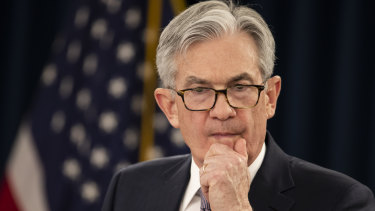US Fed seems confused by its own outlook, and that should worry all of us
There’s an interesting tension between the US Federal Reserve’s more positive views of the recovery in the US economy and the quite pessimistic expectations embedded in its projection of US interest rates.
While “upgrading” its near term outlook for the economy (it believes the loss of GDP this year will be less than it had previously forecast), the world’s most important central bank expects interest rates to be near zero until at least 2024. In real terms, that means US rates will be negative for at least the next three years.
That should say something about the lasting impact of the pandemic on the US and other economies. The US monetary policy settings signal it is going to take at least several years for economies to get back to their pre-pandemic starting points.

Those settings are, however, at odds with its economic projections, which see a return to a pre-pandemic economy by the end of next year. That looks suspect.
There’s nothing “V-shaped” about the likely road ahead – there’s an array of big risks and uncertainties – and even the relatively modest recovery implied by the Fed’s forecasts is conditional on the course of the virus.
As Victorians have experienced and Europeans can now attest to, the potential for sudden and violent outbreaks of the virus is real and has very damaging economic and social consequences.
Underlying the Fed’s more optimistic assessment of the state of the US economy is a belief that it is recovering faster than the central bank anticipated in June. Where it had forecast a year-on-year decline in fourth-quarter GDP of 6.5 per cent it now sees a fall of “only” 3.7 per cent.
That lower-than-expected impact this year – a higher base – does, however, mean a slight downgrading of growth next year, from 5 per cent to 4 per cent, and in 2022 from 3.5 per cent to 3 per cent.
The revisions to the Fed’s outlook fit with the latest OECD projections, which show a similar expectation that the impact of the pandemic on the global economy will be somewhat less severe than originally forecast, subject to the course of the virus.
The Fed’s statement said the pandemic would continue to weigh on economic activity, employment and inflation in the near term “and pose considerable risks to the economic outlook over the medium term”.
The “lower for longer” projections for US interest rates embodied in its statement fit within the new US monetary policy framework the Fed unveiled last month under which it will seek to generate, rather than contain, inflation. What had been a 2 per cent ceiling on inflation will become an average over time as the Fed tries to facilitate stronger economic growth.
The disclosure of that new framework last month might explain why the market response to the Fed’s projections of no material change in US rates until at least 2024 was subdued. In the past the prospect of negligible nominal rates in the medium terms would have buoyed equity markets.
Instead the S&P 500 slid 0.13 per cent and the tech stocks that have underpinned sharemarkets’ massive recoveries since March fell further. The technology-laden Nasdaq index was down 1.25 per cent and the biggest of the tech stocks – the so-called FAANGs – were down 1.64 per cent.
Bond yields barely moved, with the yields on two-year Treasury notes unmoved and 10-year bond rates rising a basis point. The two-year notes yield 0.13 per cent and the 10-year bonds 0.69 per cent.
Presumably, the markets had already priced in the scenario that has now been given flesh by the Fed, which raises the question of whether the momentum that has propelled the market’s surge since March, when the Fed’s slashing of rates and its reignition of the quantitative easing it employed in response to the financial crisis saw a dramatic turnaround in sharemarkets, will be sustained.
The market reaction may signal that investors expected more even though it does appear that the Fed has just about emptied its armoury of monetary policy weapons.
That support from open-ended cheap liquidity and credit is still there. The Fed said that “over the coming months” it will increase its holdings of Treasury securities and mortgage-backed securities at least at the current pace “to sustain smooth market functioning and help foster accommodative financial conditions”.
Since March the Fed has bought almost $US2 trillion ($2.75 trillion) of Treasury notes and bonds and about $US1 trillion of mortgages. Since June it has been buying about $US80 billion of bonds and $US40 billion of mortgages each month.
The market reaction may signal that investors expected more – a negative federal funds rate, perhaps, or larger-scale securities purchases – even though it does appear that the Fed has just about emptied its armoury of monetary policy weapons.
The absence of a more enthusiastic response to the stronger growth outlook and “lower for longer” rate outlook might also have been because those investors saw, and were confused by, the conflict between the projections.
As has been the case with the Reserve Bank here, the Fed’s chairman, Jerome Powell, continues to urge legislators to inject more fiscal stimulus into the US economy.
The US version of our Jobkeeper, a program that funded $US600 a week in additional unemployment benefits, ended in July and has yet to be replaced as the Republicans and Democrats wrangle over the scale of any new stimulus package.
While the US unemployment rate has fallen significantly from its peak and the Fed sees it continuing to fall, from 7.6 per cent in the further quarter this year to 5.5 per cent next year and 4 per cent by 2023, there are still millions of jobs lost and yet to be recovered. Consumer spending had shown strong signs of recovery but is now faltering. Bankruptcies are surging.

The US continues to record high, albeit falling, levels of coronavirus infection and deaths. Its smaller business sectors, in particular, will be smaller and the survivors will carry deep scars into the future and the social impacts, which have fallen disproportionately on the least advantaged, will continue to fester. Wall Street has had a good pandemic; Main Street hasn’t fared anywhere as well.
That is, of course, the economic experience of the pandemic elsewhere, albeit to varying degrees, where the outcomes have been driven by the quality of the health and fiscal responses.
The US has struggled, relative to most other developed economies, on both fronts and therefore the Fed’s monetary framework and its expectations of zero rates for years might be a better guide to its outlook than its economic projections of a relatively quick recovery.
The US influence on the global economy and markets means the resolution of that disconnect between US monetary policy settings and economic projections matters, not just to Americans, but to the rest of us.
Business Briefing
Start the day with major stories, exclusive coverage and expert opinion from our leading business journalists delivered to your inbox. Sign up for the Herald‘s here and The Age‘s here.
Market Recap
A concise wrap of the day on the markets, breaking business news and expert opinion delivered to your inbox each afternoon. Sign up for the Herald‘s here and The Age‘s here.
Stephen is one of Australia’s most respected business journalists. He was most recently co-founder and associate editor of the Business Spectator website and an associate editor and senior columnist at The Australian.
Most Viewed in Business
Source: Thanks smh.com